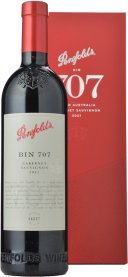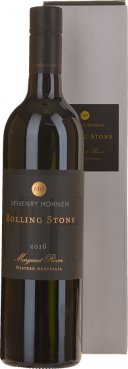$100 and over
Penfolds Bin 707
Bin 707 is a Cabernet Sauvignon reflection of Grange, intensely-flavoured fruit, completion of fermentation and maturation in new oak, expressing a Penfolds understanding of multi-vineyard, multi-region fruit sourcing. Bin 707 was first vintaged in 1964. The wine was not made from 1970 to 1975 when fruit was directed to other wines, nor in 1981, 1995, 2000, 2003 or 2011 (when fruit of the required style and quality was not available). Full bodied and with proven cellaring potential, Bin 707 retains a secure place among the ranks of Australias finest Cabernets.
PAVILLON ROUGE DU Chateau Margaux Second wine of Chateau Margaux
The second wine of Chateau Margaux came about partly due to misfortune - when an attack of phylloxera decimated the vineyards, necessitating a replanting of the majority of their vineyards. The lack of grapes eliminated the possibility of a First Growth Quality wine and led to the production of their second wine - the Pavillon Rouge de Chateau Margaux, the first official vintage of which was released in 1906. Renowned as a sterling example of a second wine, the 2016 has been hailed as a particularly superb vintage. Medium-bodied, silky, intense and tannic, it continues its impressive trajectory year upon year.
Opus One Cabernet Blend
Opus One is the coming together of two of the world's supreme wine figures, Baron Philippe de Rothschild and Robert Mondavi. Opus One began its life in 1979 when Château Mouton Rothschild winemaker Lucien Sionneau and Robert Mondavi's son, Timothy made the partnership's first vintage. Their goal was to create a wine of unparalleled quality that reflected the traditions of both houses. The wine is French in style, but Californian in substance, Opus One is produced with the utmost attention to detail. The 2006 Opus One is a traditional Bordeaux style blend of Cabernet Sauvignon, Merlot, Cabernet Franc, Petit Verdot and Malbec. The wine shows saturated black fruit concentration with flecks of purple in the glass. The nose is one of dark chocolate, blackberry, smallgoods and rose petal. In the mouth, flavours of cassis and coffee with robust plum and cherry are only a small taste of how great this wine will become with careful cellaring.</p>
Penfolds Bin 407 Cabernet Sauvignon
Penfolds Bin 407 began life back in 1993 with the release of the 1990 vintage Cabernet Sauvignon. Created as a result of the availability of high quality Cabernet fruit, Bin 407 is inspired by its older brother, Bin 707. Not only offering varietal definition, but also approachability, structure and depth of flavour. The Bin 407 highlights the Penfolds approach to multi-region, multi-vineyard blending to create a Cabernet that rewards the drinker in both early and later years.
Napanook Cabernet Blend
NAPANOOK Cabernet Blend, Napa Valley The second wine of Napa Valley’s famed Dominus Estate, this wine is made solely from grapes grown at the historic Napanook Vineyard in Yountville, Napanook is blended from vineyard blocks carefully selected for their lively fruit, soft tannins, and early maturing characteristics. The wine is created to be consumed young and enjoyed with food, but will also age well for more than a decade. The vineyard is entirely dry-farmed, allowing the vines to draw deeply on the land’s unique geology. The viticulture and winemaking are undertaken meticulously, with the objective of producing wines that are pure, balanced, and complex. Minimal intervention and restraint throughout the process of grape berry selection, fermentation and ageing preserve the character of the fruit. The resulting wines, with a tremendous potential for ageing, convey the very personality of this historic vineyard.
Moss Wood Moss Wood Vineyard Cabernet Sauvignon
Moss Wood Moss Wood Vineyard Cabernet Sauvignon, Margaret River Moss Wood is one of the Margaret River originals (planted 1969; first vintage 1973) and this iconic flagship wine Langtons Classified since 1990 has long been Western Australias leading Cabernet Sauvignon. Figures from the cellarage company Wine Ark show that it consistently rates as Australias Most Collected Cabernet. Moss Wood Cabernet Sauvignon is intensely perfumed and finely structured with cassis-blackcurrant aromas, hints of cedar and touches of violet. The oak and fruit are neatly balanced. With proven ageing potential the wine develops subtle earth/demi-glace briar characters on the bouquet, and complexity and suppleness on the palate. The unirrigated and widely spaced vineyard (now 14.86-hectares) is planted on gentle north-east facing slopes with sandy loams to a gravelly red/brown loams over clay. Typically the fruit is hand-picked, de-stemmed into open tanks and hand-plunged four times a day until completion of fermentation. At the end of vinification, the wine is allowed to macerate for around 10 to 14 days prior to pressing off into barrel. The wine is matured in 30% new and seasoned French oak barriques for 24 months.
CHATEAU LA MISSION-HAUT-BRION Cru classe
Château la Mission Haut-Brion is on uniquely stony soil in the Pessac-Léognan appellation close to the city of Bordeaux. It is a Cru Classé in the Graves Classification of 1953. The 22.5 hectare red wine vineyard is planted to Cabernet Sauvignon (46%), Merlot (44%) and Cabernet Franc (10%). The chateau wine is vinified in large (180hl) temperature-controlled, stainless steel vats and aged in 100% new French oak for an average of 22 months. Annual production is 6000-7000 dozen. The famous white wine of the chateau comes from 3.5 ha planted to Semillon (62%) and Sauvignon Blanc (38%). Overall planting density is 10,000 vines per hectare (red) and 8000 vines per hectare (white). Since 1983, under the ownership of Domaine Clarence Dillon (which also owns the neighbouring Chateau Haut Brion), the entire estate has been renovated vineyards, winemaking facilities and the chateau itself. The property got its name in the 1600s when it was owned by the Catholic Church.
Mayacamas Vineyards Cabernet Sauvignon
MAYACAMAS VINEYARDS Cabernet Sauvignon, Napa Valley Not much has changed by way of production since Bob Travers started the Mayacamas estate in the early 1940s. The fruit is handpicked early, often in early September - abvs usually end up between 13 and 14 percent to preserve natural, altitude derived acidities. Fermentations occur predominantly in open-top cement vessels which were built in the 1950s, again to preserve acidities and vibrant fruit character. Extended ageing occurs exclusively in neutral oak some as old as 100 years typically for three years which allows the vineyard's expression to shine through the powerful fruit profile, while also minimising oxygenation and helping to maintain the powerful and tight tannin structure Mayacamas is so famous for. The wines then usually spend a further two years in bottle before it is ready to be released to the market. Mayacamas make wines that lie in stark contrast to the more prevalent rich, heavily oaked, high in abv, bombastic wines that are common in the Napa Valley.
Joseph Phelps Cabernet Sauvignon
Mchenry Hohnen Rolling Stone Cabernet
MCHENRY HOHNEN Rolling Stone Cabernet Malbec Petit Verdot, Margaret River



























































